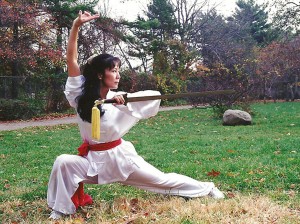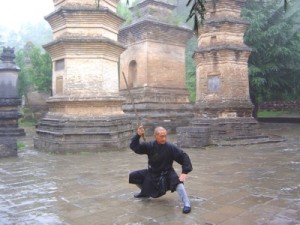 The Hidden Functions of Forms
The Hidden Functions of Forms
Do you know what you’re really learning?
By Stefan Verstappen
Originally Published in Inside Kung Fu Magazine March ’05
It’s an argument we have all heard before, ‘Since you would never fight in a sequence like a form, what is the use of practicing forms?’ This argument is valid to the extent that if all you want to learn is how to fight then forms are not necessary. But if you want to improve your overall physical, emotional, and sensory health then forms training is the key. Form are not designed to merely teach combat techniques, there are three other levels and skill sets inherent in forms training that you are learning whether or not you know it.
A therapy which encourages expressive movement increases the motility of the organism, improves its aggression and creates a feeling of strength on both the physical and psychic levels.
Alexander Lowen, The Language of the Body
The Functions of Form
The obvious reason for learning forms is that they teach combat techniques, but in addition there are three purposes behind the practice of forms, they are: as a mnemonic device, to develop the muscular/skeletal system, and to improve psycho?motor skills.
Mnemonic Technique
A form is a mnemonic technique that trains the muscles to remember the many complex techniques of hand-to-hand combat of which a martial art is composed. Let’s make an analogy between learning martial arts and learning the piano. A single technique such as a punch or a kick could be likened to a single musical note. In the beginning you learn the notes of a piano individually and then in scales. Martial arts first teach the techniques individually and then in drills which is similar to practicing scales. Once proficient in notes and scales the next progression is to songs and melodies. In martial arts combat techniques are combined into routines that correspond to songs and are combined differently in each routine, from simple progressions to complex ones.
So how does this work as mnemonic device?
Well one of the first uses of music and possibly even the cause of its invention was as a mnemonic device. Ancient bards knew the words to dozens of stories because the stories were sung rather than spoken. This principle is easily demonstrated. If I were to ask you to memorize six notes, C, A, F, A, C, F, in order and I would only tell you once and you were not allowed to write it down. What are your chances of remembering those notes in an hour, or the next day, or next week or when you were 80 years old? Slim to none. But if I were to sing the first six notes of the American national anthem, ‘Oh-say-can-you-see….’ you would be able to remember those notes until the day you died. Music has the ability to encode, and allows the mind to recall, complex packets of information.
Forms then are the physical equivalent of music. A form contains packets of kinesthetic information such as posture, balance, center of gravity, movement, fluidity, and the transmission of kinetic energy. By learning forms one also memorizes the dozens of combat techniques of which it is comprised. And like the tales sung by bards, martial arts forms have also transmitted this information down through dozens and perhaps hundreds of generations.
Development of the Muscular/Skeletal System
Forms also work to exercise different areas of the body simultaneously. Practicing forms quickly will develop the cardiovascular system, improve flexibility and anaerobic capacity, and increase the body’s metabolic rate. But in addition, forms also work the often overlooked stabilizer muscle groups. We all know that the body’s large muscles groups such as the quadriceps, gluteus, and abdominals are responsible for strength, and speed. However, posture and balance is achieved through the actions of hundreds of small muscles known collectively as stabilizer muscles. These muscles help to direct the movement of the larger muscles that are essential in executing techniques that require refinement and grace. These stabilizer muscles don’t develop very much through traditional weight exercises that are aimed at isolating and developing the large muscles which is why body builders often appear stiff and wooden. Conversely figure skaters, dancers, and gymnasts are renowned for their poise a result of training that requires superb balance and posture. Because form training requires similar attention to posture and balance they also help to develop grace and fluidity.
Psycho-Motor Skills
Psycho-motor skills are those that involve the movement of the body in space, generally referred to as hand-to-eye coordination. Forms teach a complex set of positions and movements order isotretinoin cheap usa that require more attention than we normally have. For example, when you first learn a form you must practice very slowly, stopping after each posture to look and check on the position of your hands, arms, feet, legs, shoulders, hips, head and back. As you progress you develop your sense of proprioception which enables you to sense your posture rather than checking it visually. This frees the use of your eyes and attention which can then be used to concentrate on other aspects such as breathing, visualization, or an opponent. The nervous system is trained to monitor and perform a far broader range of bodily expressions, without the need for conscious direction.
This is why someone with a background is gymnastics or ballet tends to learn martial arts forms faster than say someone who only played soccer. There are simply many more postures and positions to learn in dance and gymnastics than soccer, which increases the body’s repertoire of movements.
Finally, forms require movements be done both right and left handed. As you know the brain is divided into a right and left hemisphere, and that the left brain controls the right side of the body and vice versa. Cat Scan studies show that when both the left and right hemispheres of the brain are stimulated in synchronization that people often experience peak mental acuity and alertness. One way to trigger both sides of the brain is what’s called cross lateral exercises, simply put, something that is done both by the right side of the body and then by the left side. This is exactly what occurs during the performance of a form. In effect then, practicing forms will make you smarter!
We tend to stop learning when we have mastered sufficient skills to attain our immediate objective. Thus for instance, we improve our speech until we can make ourselves understood. But any person who wishes to speak with the clarity of an actor discovers that he must study speech for several years in order to achieve anything approaching his maximum potential. An intricate process of limiting ability accustoms us to make do with a small part of our potential.
Moshe Feldenkrais, Body Awareness As Healing Therapy: The Case of Nora
Chinese Tips for Training in Form
As you can see forms are a great way to improve both mind and body but keep forms alive and interesting you should occasionally change the way they are performed or add other outside elements. The following are some tips on getting the most out of your forms training.
In China and rural Japan, much time is spent training outdoors, in the parks, along beaches, and in the mountains. These varied conditions improve balance and stability to deeper levels than the uniform flat surfaces we usually train and spend our working days on. All martial artists should train under different terrains and conditions. By expanding one’s experience with varied conditions, one is better able to react and move under a greater number of combat situations. Practice your forms on hills, along the beach, on rocky ground, in the snow, and during a rainstorm. Practice at night in candlelight or moonlight. The first thing you will notice is the incredible strain this puts on the legs spurring the development of stronger leg muscles. One also learns to move more perfectly balanced since the ground is often unreliable being either to slippery or too entangled to allow any degree of error.
Increased Difficulty
In earlier times brass or steel rings were worn around the wrists and ankles to add weight during the performance of the form. Special wrist and ankle weights can help in the development of muscles, and endurance. Light dumb bells can also be substituted. Most important, be careful not to perform the movements too quickly since the weights tend to make you overextend your techniques which can cause injury to the joints.
Varied Speed
Practice the form as slowly as possible, as though a tree gently swaying in the wind. It doesn’t matter what style you practice, the method of practicing slowly will provide the same benefits as Tai Chi. The form will have to be adapted to suit the slower speed, kicks become slow steps, requiring not only excellent muscle control but balance as well.
Conclusion
The heart and soul of any martial art is in the way you move. Following precise directions for moving the body does more that simply train you for combat, it improves concentration, self awareness, coordination, versatility, balance, rhythm, and harmony – it teaches you to be alive.
